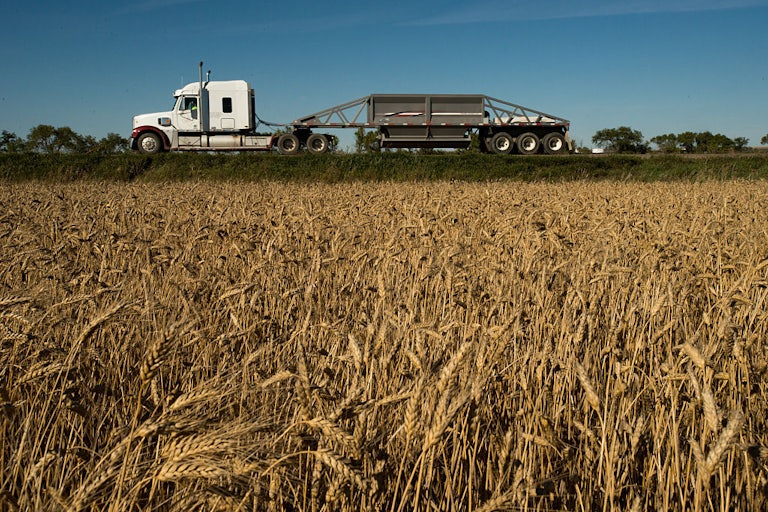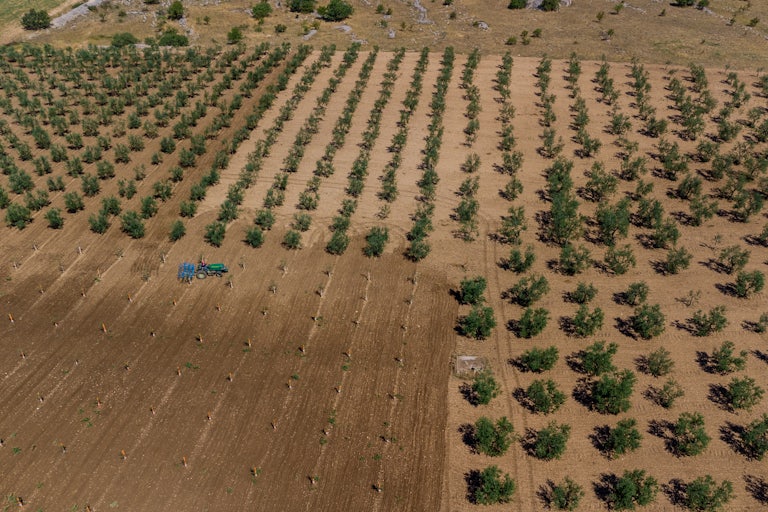American Farms Have a Drug Problem
The meat industry is pumping livestock full of antibiotics, exacerbating drug resistance in humans.

Imagine if we were to lose the tremendous medical advances of the past century. If people began to routinely die from what we now consider minor infections. If the surgeries we’ve come to take for granted suddenly got much, much riskier.
This isn’t that far-fetched. The growing risk from drug-resistant bacteria, fungi, viruses, and parasites, England’s former chief medical officer Sally Davies told The Guardian in an interview published this week, is “more acute” than climate change and could make Covid-19 “look minor.” Among the many dangers, The Guardian’s Kat Lay reported, is that “widespread resistance would make much of modern medicine too risky, affecting treatments including cesarean sections, cancer interventions and organ transplantation.”
This is scary stuff—all the more so because drug resistance is often presented as a massive, multifaceted problem that is nearly impossible to tackle. Maybe you’ve heard of it in the context of doctors overprescribing antibiotics, or patients not taking the full course of antibiotics when they are prescribed. Maybe you’ve heard of drug-resistant tuberculosis developing and circulating in prisons, or maybe you’ve been told that the chief driver is overprescription of antibiotics in low-income countries, meaning that solving this would require an unprecedented level of global coordination and foreign aid.
Drug resistance is a complicated, multifaceted problem—and it will require global coordination. But there’s one really large lever we could pull that would make it much more manageable. And while some articles on drug resistance don’t mention it, Davies does: animal agriculture.
Over two-thirds of all antimicrobials sold globally wind up in farm animals—73 percent, by some estimates. The meat industry has historically fed animals antibiotics not just to treat illness but to make them grow faster so it can kill and sell them faster. While the Food and Drug Administration stopped allowing that in the United States as of 2017, industrial meat, dairy, poultry, egg, and aquaculture operations still use a lot of antibiotics because of the extreme density in which these animals are raised. Also, antibiotics aren’t always administered at an individual level in response to illness but can be given as a preventative measure, or to an entire group.
The U.S. remains way up in the charts in farm animal antibiotic use—third worldwide, after China and Brazil. While China now seems to be reducing antimicrobial use in farming, analysis by the Natural Resources Defense Council and One Health Trust found a troubling trend in the U.S.: If you look at the total amount of antibiotics by weight, while human medicine reduced its use of “medically important antibiotics” from 2017 to 2020, livestock farming used more. After that sharp drop around 2017, livestock production’s share of antibiotic use again crept upward, from about 62 percent of antibiotics sold in 2017 to 69 percent in 2020.
Overuse of drugs in livestock production can affect humans in several ways. Eighty percent of the antibiotics given to animals, Davies told The Guardian, then gets excreted in their waste, meaning antibiotics can pass into the environment, increasing selective pressures that contribute to antibiotic resistance. Drug residue can also persist in animal products that consumers then ingest. (Although the U.S. Department of Agriculture has a sampling and testing system to prevent the sale of meat with drug residue, with thresholds or “tolerance levels” set by the FDA, that does not mean there is no residue.) Drug-resistant bacteria that develop in animals deluged with antibiotics can contaminate improperly handled meat or pass via animal feces to plant crops.
There are ways to fix American farming’s drug addiction. We know that because the intensity of antibiotic use on farms in Europe is about half that in the United States.
The U.S. could catch up by instituting regulations that encourage or mandate better hygiene and general living conditions and more nondrug preventative care. This would have multiple benefits for human health: As TNR contributor Melody Schreiber recently reported, animal farming—not wild birds, as some narratives suggest—has been the primary driver of bird flu. “Once bird flu gets into a large-scale poultry or, now, a dairy operation, it can spread quickly in cramped confines, and then spread to other farms before spilling back into wild birds and animals.”
Another way to cut antibiotic use worldwide would be to eat less meat. One estimate suggests reducing global meat consumption to the equivalent of one standard fast-food burger per person per day—average U.S. consumption is currently over six times that—would slash the global use of antimicrobials for food animals by 66 percent. This would have the salutary effect of reducing greenhouse gas emissions, waterway contamination, deforestation, biodiversity loss, and more.
While the long-delayed farm bill is back in headlines this week, so far most of the focus is on tracking foreign land purchases, cannabis, and GOP efforts to avoid the words “climate change.” Instead of state-level regulations improving how poultry, hogs, and cattle are raised, Florida and Alabama have opted to ban lab-cultivated meat—which isn’t for sale anyway. And nothing gets culture warriors worked up faster than the slightest hint of a suggestion that people eat less meat—or any regulation that might make it marginally more expensive.
Then again, maybe they’d feel differently after a few public awareness campaigns. One poll in 2019 found that while the vast majority of the American public has heard about antibiotic resistance, their understanding of what antibiotic resistance could mean for their own lives is patchier. And while 59 percent say pharmaceutical companies are “very responsible” for the problem, only 20 percent would say the same of the agricultural industry.
Antibiotic resistance isn’t solely an agricultural problem, of course. Davies—who lost her goddaughter to a multidrug-resistant bacterial infection—also noted the necessity of developing new drugs, international coordination, and reducing the release of antibiotics into the environment during manufacturing.
But we can hold these two truths in our minds simultaneously: Any serious effort to slow the rise of drug-resistant pathogens is going to have to address multiple issues. Any effort that ignores the industry in which two-thirds of the drugs are being used isn’t serious.
Good News/Bad News
![]()
A landmark bill to make fossil fuel companies cover some of the costs of repairing and adapting to the damage of climate change passed its final vote in the Vermont Senate this past week. If Governor Phil Scott vetoes, the General Assembly will reconvene in June for an override, according to the Bennington Banner. (Vermonters supported the policy by a 2-to-1 margin even before last year’s catastrophic floods.) When the bill becomes law, it will surely be challenged in court. Whatever happens, this is a story to watch.
![]()
Mere days after a report revealed that former President Donald Trump promised a roomful of oil execs that he would reverse loads of regulations in exchange for $1 billion in campaign funds, the Republican hopeful pledged to issue an executive order halting all offshore wind development “on day one,” if elected.
Stat of the Week
2,000 years
Tree rings indicate that last summer was the hottest Northern Hemisphere summer in two millennia, a new study says.
What I’m Reading
While former President Donald Trump has joined a growing chorus of conservatives groundlessly blaming wind farms for whale deaths, the clear culprit in a recent string of endangered right whale deaths is vessel strikes. The Washington Post uses the disappearance and likely death of a 1-year-old right whale named Bishop to examine how this happens, laying out how delayed fishing reforms and proposals to expand low-speed zones along the coast could help save the species.
So far this year, a dead female turned up off Virginia with a dislocated spine, a calf was discovered in Georgia with head lacerations, and a young female was found—again in Georgia—with a fractured skull. All the injuries are consistent with vessel strikes.… In addition to vessel strikes, right whales are also threatened by entanglement in fishing gear stretched deep into the sea to trap lobsters and crabs. Bishop’s family tree underscores the danger.
Bishop’s mother, Insignia, endured four entanglements over the course of her life. She was last sighted in 2015 and is presumed dead. She was the mother of four known calves.… Bishop’s great-grandmother Wart was the matriarch of a family of 31 known whales and counting. Her prodigious family tree highlights how the untimely death of just one female can reduce the species’ future population. Here is Wart in the Gulf of Maine in 2010, with fishing line going through her mouth and over her head. She was last sighted in 2014 and is presumed dead.
Read Harry Stevens and Dino Grandoni’s report at The Washington Post.
This article first appeared in Life in a Warming World, a weekly TNR newsletter authored by deputy editor Heather Souvaine Horn. Sign up here.









